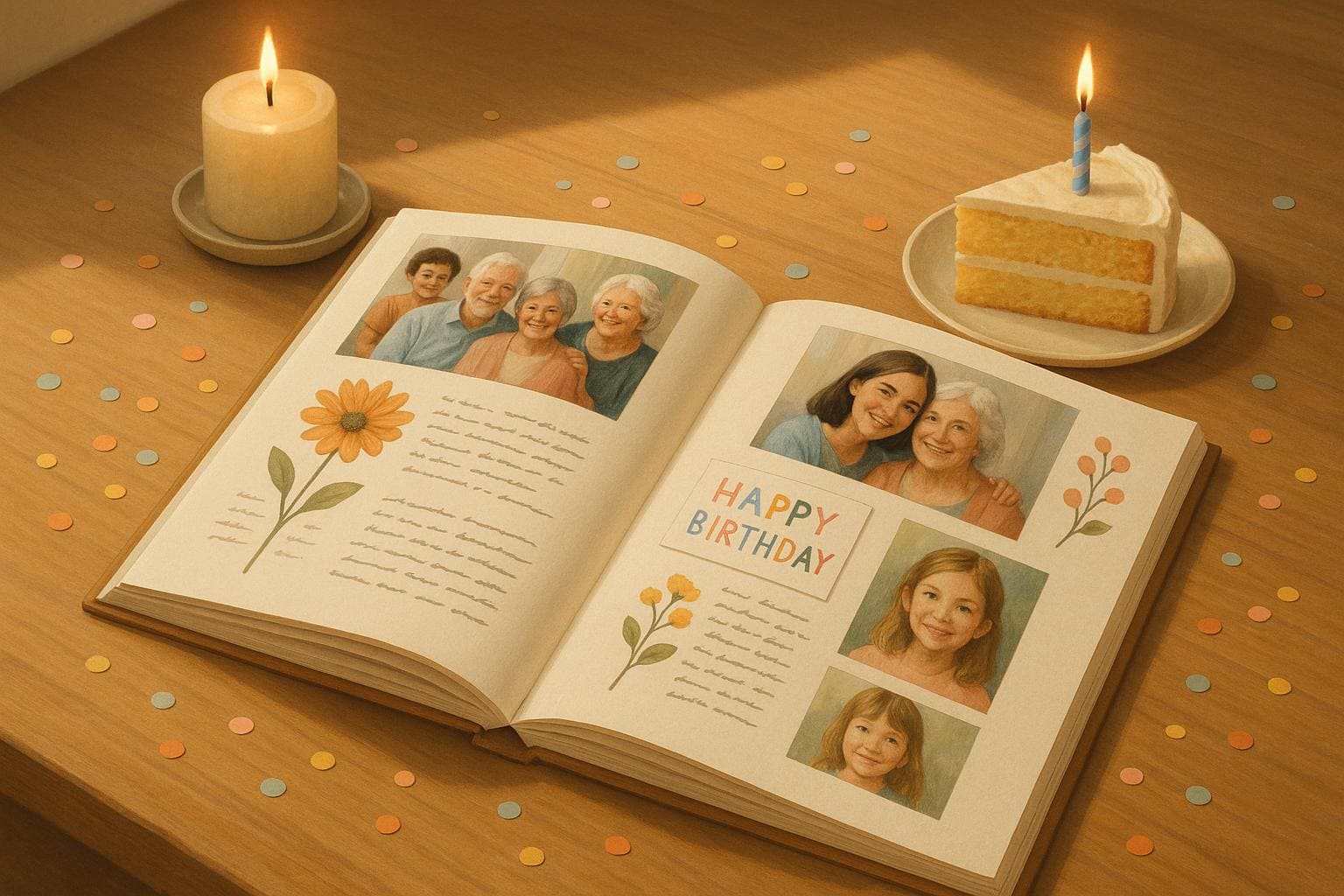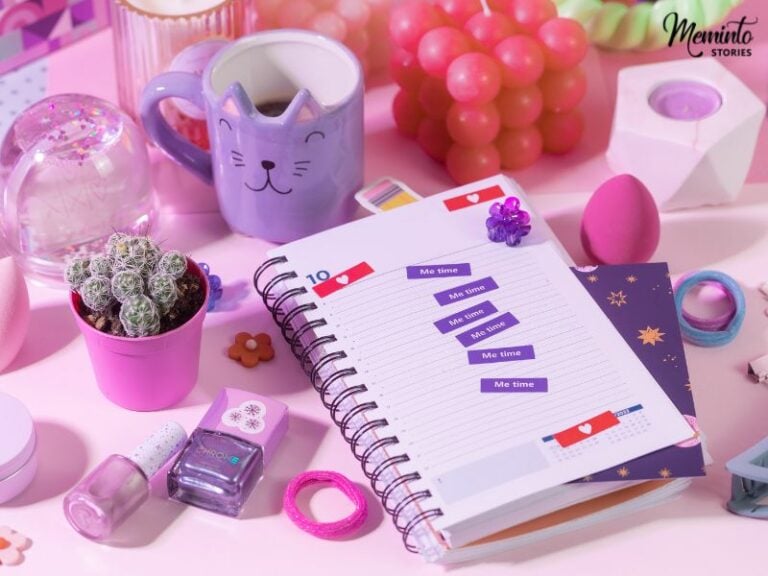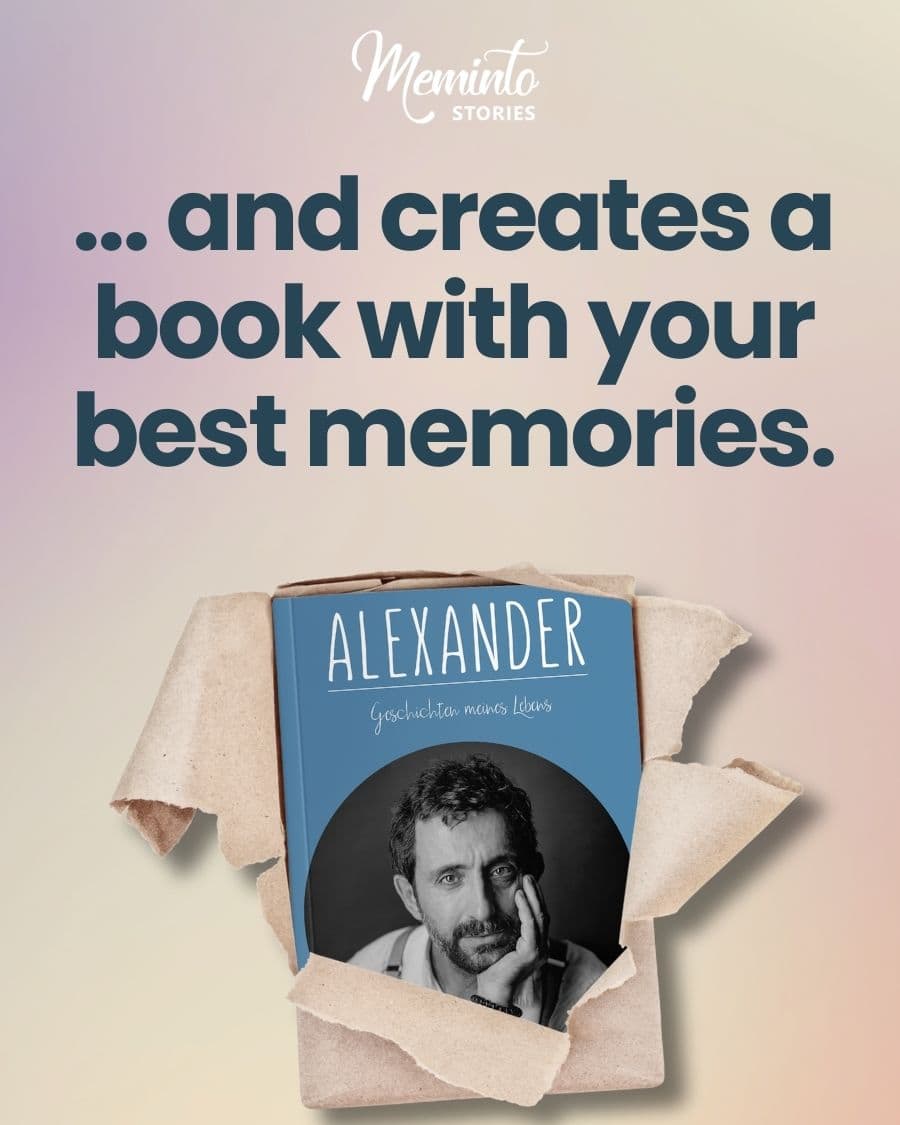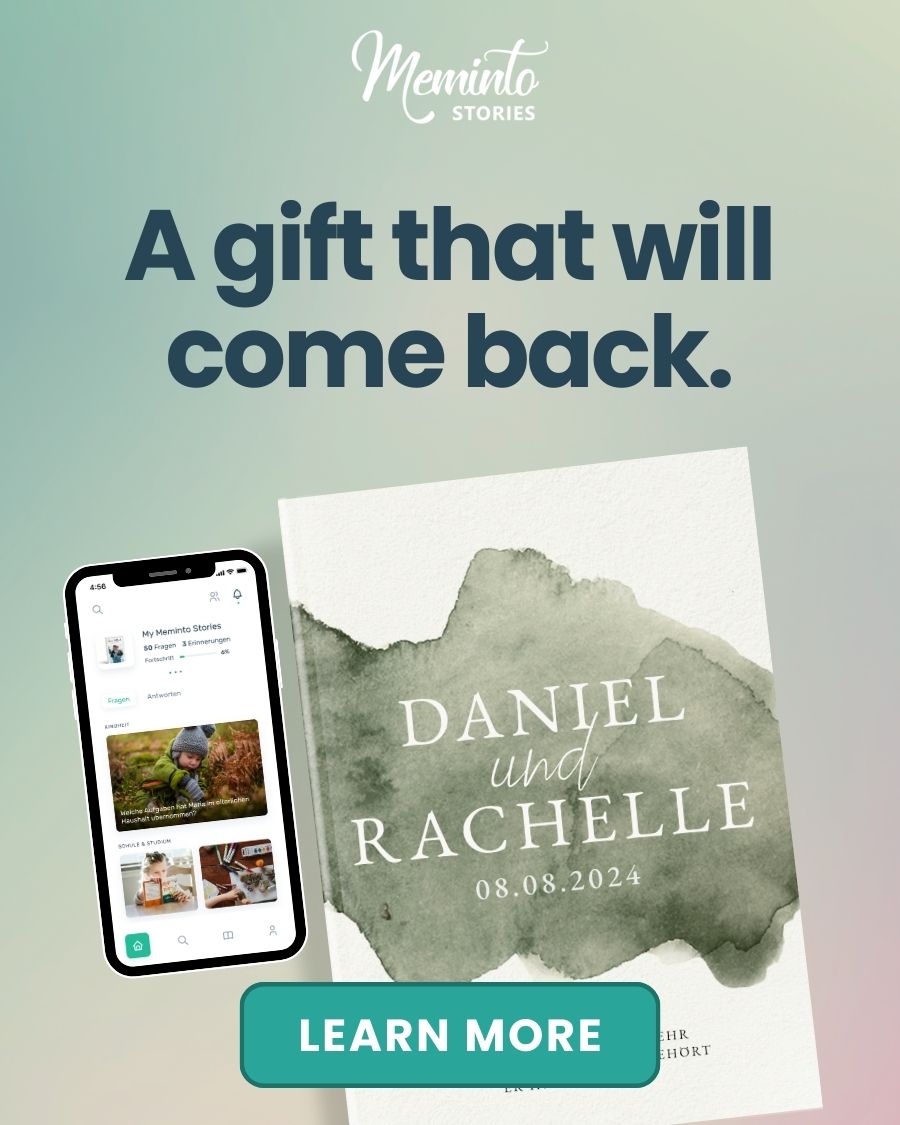Creating a family memory book for milestone birthdays is a meaningful way to celebrate life’s special moments. Whether it’s a 50th, 75th, or a sweet 16, these books preserve memories, stories, and connections that can be cherished for generations. Here’s a quick overview of ideas to make your memory book unforgettable:
- Family Tree with Photos: Map out generations and relationships with pictures and details.
- Personal Messages: Collect heartfelt notes, video messages, or handwritten letters from loved ones.
- Life Milestones Timeline: Highlight key achievements and events with photos and captions.
- Family Recipe Collection: Include cherished recipes with stories behind them.
- Growing Up Stories: Share childhood memories, family traditions, and important lessons.
- Best Moments Photo Collection: Showcase milestones, family gatherings, and candid shots.
- Family Celebrations Timeline: Document holidays, reunions, and special events over the years.
- Life Lessons Across Generations: Reflect on wisdom and advice passed down in the family.
- Life Accomplishments Gallery: Celebrate the celebrant’s achievements with photos and memorabilia.
- Messages from Young Family Members: Add drawings, notes, or video clips from kids.
For a polished and interactive memory book, consider using digital tools like Meminto Stories to include videos, voice recordings, and professional hardcover printing.
BIRTHDAY SCRAPBOOK IDEAS | DIY Memory Book for …
Must-Have Elements for Birthday Memory Books
Creating a birthday memory book takes thoughtful planning and a mix of key elements to tell a meaningful life story. Each piece contributes to a book that captures your family’s journey and celebrates cherished moments.
Stories and Narratives
Include detailed accounts of important events, personal anecdotes, and treasured memories. Guided questions can help bring these stories to life. As Verena, 32, shared:
“So much more than just a photo book. Through the questions, beautiful old memories come up again. Even videos could be loaded into the book. Emotions like when it all happened!”
Visual Elements
Photos bring the book to life. Use a mix of:
- Milestones and achievements
- Historical family pictures
- Recent celebration snapshots
- Candid moments that show personality
- Photos from special occasions
Personal Messages
Heartfelt notes, from birthday wishes to life advice, add a deeply personal touch to the memory book.
Organizing the Book
Divide the book into sections for a clear and engaging flow. Here’s a simple structure to follow:
| Section Type | Content Ideas | Purpose |
|---|---|---|
| Introduction | Family tree, birth story | Sets the stage and provides context |
| Early Years | Childhood photos, family traditions | Highlights formative experiences |
| Milestones | Achievements, celebrations | Showcases important life moments |
| Messages | Written notes, recorded stories | Adds personal and emotional depth |
| Legacy | Family recipes, life lessons | Preserves heritage for future generations |
This structure ensures the book is more than just a collection of events – it becomes a celebration of a life well-lived.
Adding a Digital Touch
Enhance the memory book with digital elements using tools like Meminto Stories. Options include:
- Voice recordings of family stories
- Video messages
- Text-based narratives
- High-quality photo printing
- Professional hardcover binding
These features make the memory book even more engaging and interactive.
Planning Timeline
Start the process 2–3 months before the celebration to ensure everything comes together smoothly. Use this time to:
- Collect photos from family and friends
- Record stories and memories
- Arrange content in chronological order
- Add personal touches and custom details
- Send the book for professional printing and binding
Giving contributors enough time to share their memories is crucial. Lauren from Orlando highlights this:
“With my family, the experience became even more meaningful.”
1. Family Tree with Member Photos
A family tree is a great way to visually connect generations and celebrate family history. It provides a clear layout of relationships, making it easier to understand how everyone is linked. Here’s how to create a well-organized and visually engaging family tree.
Structure and Layout
Divide the tree into generational layers, placing the birthday celebrant at the center. From there, branch out to include:
- Parents and siblings
- Grandparents and their siblings
- Children and grandchildren
- Extended family members
Photos and Details
For each family member, include the following to add depth and personality:
- A recent portrait
- A historical photo, if available
- Birth dates and locations
- A short note explaining their relationship to the celebrant
Design Tips
Keep the layout clean and easy to follow by:
- Using uniform photo sizes for consistency
- Clearly marking relationships between family members
- Adding color codes for different family branches
- Leaving enough white space to avoid clutter
These steps will help you create a meaningful and visually appealing family tree that everyone can enjoy.
2. Personal Messages from Family and Friends
Personal messages are the heart and soul of a milestone birthday memory book. These heartfelt contributions from loved ones celebrate the relationships and moments that have shaped the celebrant’s life. They add depth and meaning, creating a beautiful tribute to their journey.
How to Gather Messages
To get meaningful responses, provide clear prompts like:
- What’s your favorite memory with the birthday celebrant?
- How have they influenced your life?
- What’s a life lesson they’ve taught you?
- What qualities do you admire most about them?
Adding Multimedia for a Personal Touch
Transform written messages into a richer experience by incorporating multimedia elements:
- Voice recordings of loved ones sharing stories
- Video messages to capture emotions and expressions
- Handwritten notes for a more intimate feel
- Photo-story combinations that blend images with personal anecdotes
Tools like Meminto Stories make it simple to collect and organize these contributions in various formats, bringing the memory book to life.
Organizing the Contributions
Once you’ve gathered messages, arrange them thoughtfully to maximize their emotional impact:
- Group messages by family branches or friend groups
- Alternate between heartfelt reflections and lighthearted stories
- Place deeply meaningful messages at key transitions in the book
- Add context by including dates or locations tied to shared experiences
Making Messages Stand Out
Encourage contributors to go beyond generic birthday wishes. Ask them to:
- Share specific memories or conversations
- Reflect on how the celebrant has influenced their life
- Include funny, touching, or memorable moments
- Offer advice or wisdom they’ve received from the celebrant
Providing clear prompts helps create a collection of stories that feel personal and genuine.
Tips for Presentation
Use guided questions to help contributors craft detailed messages. This approach not only simplifies the process but also ensures the final collection reflects the celebrant’s unique story and the bonds they’ve built.
3. Life Milestones Timeline
This timeline ties together key moments from your life, creating a visual story that connects past achievements with the ongoing journey of family memories. It serves as a central feature in your memory book, offering a clear, engaging way to reflect on your history.
Building Your Timeline
Here’s how to craft a timeline that’s both meaningful and visually appealing:
- Visual Elements: Incorporate photographs, handwritten dates with captions, themed decorations, and family keepsakes like tickets, certificates, or cards. These details add a personal touch.
- Key Life Moments: Highlight major milestones such as your birth, first steps, school achievements, career highlights, marriage, family events, travel experiences, and personal achievements.
- Contextual Details: Add depth by including historical context, family anecdotes, personal reflections, and location details to bring each milestone to life.
Adding Interactive Features
Take your timeline to the next level by including:
- Voice recordings
- Video clips
- Digital photos
- Audio snippets
These elements make the timeline more engaging and bring memories to life in a unique way.
Design Tips for a Polished Look
After adding multimedia elements, focus on creating a cohesive design:
- Keep consistent spacing for a clean layout.
- Emphasize major milestones with bold or highlighted text.
- Use brief descriptions to explain each event.
- Add handwritten notes for a personal touch.
- Pick colors that complement your theme.
Choosing the Right Organization Style
Depending on your vision, select a timeline style that best suits your needs:
| Timeline Style | Best For | Key Features |
|---|---|---|
| Chronological | Traditional approach | Follows events year by year. |
| Thematic | Grouped life events | Organizes milestones into categories like career or family. |
| Visual Journey | Photo-focused stories | Relies on images with minimal text. |
| Interactive | Digital integration | Combines multimedia with printed elements. |
Each style offers a unique way to showcase your story, so choose one that resonates with your goals and the memories you want to preserve.
4. Family Recipe Collection
Create a special section dedicated to preserving your family’s culinary traditions and sharing the stories behind treasured recipes.
Building Your Recipe Collection
Collect recipes that carry meaning for your family:
- Handwritten Recipes: Scan old recipe cards, including any personal notes or scribbles.
- Family Favorites: Write down dishes that make an appearance at every gathering.
- Generational Recipes: Record recipes that have been passed down through the years.
- Holiday Specialties: Include recipes tied to specific celebrations or traditions.
Key Elements for Each Recipe
Include these components to make your recipes more meaningful:
| Element | Purpose |
|---|---|
| Recipe History | Share the origin and significance of the dish. |
| Cooking Notes | Add tips, tricks, or personal tweaks. |
| Memory Caption | Highlight a story or memory tied to the recipe. |
| Photo Space | Include pictures of the dish or family members preparing it. |
Adding Interactive Features
Make your recipe collection engaging with these ideas:
- QR Codes: Link to videos of family members demonstrating the recipe.
- Voice Recordings: Capture relatives sharing cooking tips or stories.
- Recipe Timeline: Show how the recipe has evolved over generations.
- Preparation Rituals: Highlight any unique cooking traditions.
Tips for Recipe Page Design
Keep your recipe pages organized and visually appealing:
- Use a consistent format for ingredients and instructions.
- Leave space for future notes or updates.
- Include measurement conversions for easy reference.
- Add family photos to make the pages more personal.
Organizing Recipes by Category
Sort your recipes into easy-to-navigate categories:
| Category | Description |
|---|---|
| Birthday Classics | Dishes that are staples for birthdays. |
| Holiday Favorites | Foods tied to seasonal celebrations. |
| Family Comfort Foods | Everyday meals loved by everyone. |
| Heritage Dishes | Recipes that reflect your cultural roots. |
This collection not only keeps your family’s recipes alive but also creates a space to share memories and traditions for generations to come.
5. Growing Up Stories
Growing up stories are a cornerstone of any milestone birthday memory book. These stories capture key moments that define a person’s life, preserving family history and fostering connections across generations. They create a living record of personal growth and shared experiences.
Types of Stories to Include
To make your memory book truly special, consider including stories from these categories:
| Story Category | Content | Purpose |
|---|---|---|
| First Experiences | First day of school, learning to ride a bike, first pet | Highlights important milestones |
| Family Traditions | Holiday celebrations, annual vacations, special rituals | Preserves family culture |
| Childhood Home | Description of rooms, neighborhood adventures, gatherings | Captures the setting of early life |
| School Years | Academic achievements, favorite teachers, best friends | Tracks educational memories |
| Family Adventures | Memorable trips, weekend outings, family reunions | Celebrates shared experiences |
Collaborative Storytelling
Involving family members in storytelling adds depth and perspective. Each person brings their own memories and emotions, creating a richer narrative. These shared efforts not only enhance the stories but also strengthen family bonds.
Capturing Emotions
Don’t just focus on the events – capture the emotions tied to them. For example, one mother, Selma, shared her experience:
“With Meminto Stories I found a way to keep all my flashbacks of the first adventure with our child in a book. Now we can cherish them forever.”
Making Stories Come Alive
Add more depth to your stories by incorporating:
- Voice recordings
- Photographs
- Memorabilia like report cards or childhood artwork
- Video clips
These elements help bring the memories to life, making them more engaging and meaningful.
Story Prompts
Use thoughtful questions to help gather detailed memories:
| Focus Area | Sample Questions |
|---|---|
| Childhood Home | What was your favorite room and why? |
| Family Dynamics | What family traditions do you treasure the most? |
| School Days | Who was your best friend, and what did you do together? |
| Life Lessons | What values did you learn from your family? |
Tips for Story Collection
- Set aside regular time to record memories.
- Use guided questions to spark detailed storytelling.
- Let conversations flow naturally.
- Save memories in different formats – written, audio, or video.
- Include a mix of joyful moments and lessons learned.
These growing-up stories will only grow in importance over time, becoming cherished keepsakes for future generations to enjoy and learn from. They’re not just memories – they’re a legacy.
6. Best Moments Photo Collection
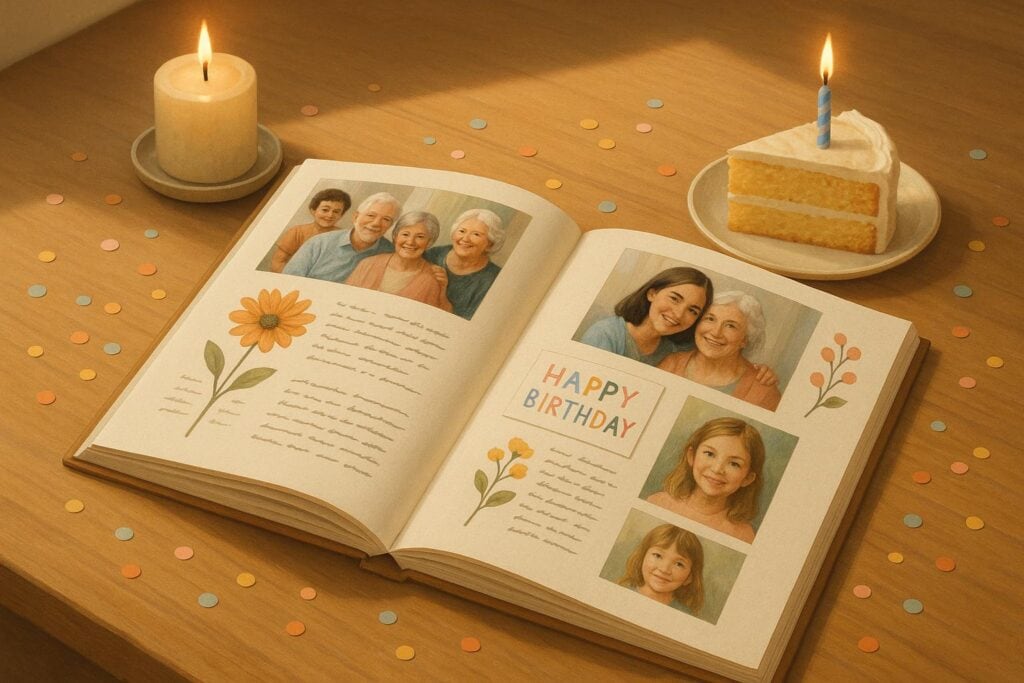
This photo collection breathes life into the stories and timelines you’ve documented. Photos create a visual narrative that perfectly complements the written memories in your book.
Photo Categories to Include
| Category | Description | Purpose |
|---|---|---|
| Childhood Milestones | First steps, birthdays, school events | Highlights early achievements |
| Family Gatherings | Holidays, reunions, traditions | Celebrates family connections |
| Life Achievements | Graduations, awards, career milestones | Honors personal accomplishments |
| Special Relationships | Friends, family, mentors | Focuses on meaningful connections |
| Travel Memories | Vacations, adventures, explorations | Captures shared experiences |
Photo Organization Tips
To create a seamless narrative, organize your photos with care:
- Chronological Order: Arrange photos in the order events occurred, showing the natural flow of life.
- Storytelling Captions: Add short captions for each photo to explain:
- When it was taken
- Who is in the photo
- Why the moment was special
- Any memories tied to it
- Image Quality: Choose clear, well-lit images that best represent the moment.
Adding Context and Depth
Make each photo more meaningful by including:
- Detailed Captions: Write descriptions that preserve the emotions and context of the moment.
- Audio Narration: Attach voice recordings to explain the importance of specific photos.
- Memorabilia: Add items like tickets, cards, or small mementos to enrich the story.
Photo Enhancement Tips
Maximize the impact of your photos with these tips:
- Use high-quality scans for older prints.
- Thoughtfully arrange photos to create an engaging layout.
- Mix formal portraits with candid shots for variety.
- Design themed pages for major events or milestones.
- Add small decorative touches to enhance the layout without overwhelming it.
Digital Integration
Take advantage of digital tools to elevate your photo collection:
- Use high-resolution digital prints for clarity.
- Experiment with dynamic layouts that guide the viewer’s eye.
- Incorporate features like QR codes for interactive elements.
Consider using Meminto Stories to seamlessly combine digital enhancements into your hardcover memory book.
sbb-itb-e3574dd
7. Family Celebrations Through the Years
Family celebrations are a key part of any milestone birthday memory book. They highlight the moments that shape your family’s story over time.
Organizing Celebrations by Theme
Here’s a quick guide to organizing family celebrations and preserving their memories:
| Celebration Type | What to Include | Memory Tips |
|---|---|---|
| Holiday Traditions | Annual gatherings, special meals, rituals | Save recipes, photograph decorations, document customs |
| Birthday Milestones | Celebrations for special ages like 16, 21, or 50 | Keep invitations, guest messages, and photos |
| Family Reunions | Multi-generational events, family games | Record shared stories, attendance, and group photos |
| Cultural Events | Heritage festivals, religious ceremonies | Include traditional outfits, prayers, and their meanings |
| Achievement Parties | Graduations, promotions, retirements | Save awards, speeches, and congratulatory notes |
Once you’ve categorized events, create a timeline to keep track of them.
Creating Celebration Timelines
A chronological timeline helps show how your family’s traditions have evolved. Be sure to include:
- Date and Location: When and where the celebration happened
- Participants: Who attended and their roles in the event
- Special Moments: Highlights from the celebration
- Traditional Elements: How family customs were included
- Changes Over Time: How the event or tradition has grown or shifted
This timeline will serve as a framework for sharing each celebration’s unique story.
Capturing Celebration Details
Make each celebration unforgettable by including:
- Handwritten family recipes
- Audio recordings of relatives sharing their favorite memories
- Videos of key moments from the event
- Photos that show how traditions have changed over time
- Mementos like cards, programs, or decorations from the day
These details bring the memories to life and make them more personal.
Interactive Elements
With tools like Meminto Stories, you can add multimedia elements like videos and audio clips to make your memory book even more engaging.
Tips for Documentation
- Capture behind-the-scenes preparations alongside the main event
- Include both planned moments and spontaneous ones
- Gather perspectives from different family members
- Focus on the emotions tied to each tradition
- Preserve a mix of formal portraits and candid shots
These small touches will help you build a memory book that truly reflects the essence of your family celebrations.
8. Life Lessons Across Generations
Life lessons create a meaningful link between past and present, offering guidance and inspiration for years to come. These shared insights often become treasured family memories, blending storytelling with timeless wisdom.
Organizing Life Lessons by Theme
| Theme | Description | Collection Method |
|---|---|---|
| Family Values | Core principles passed through generations | Audio interviews, written reflections |
| Career Wisdom | Lessons and advice from professional experiences | Video recordings, personal stories |
| Life Skills | Practical knowledge and know-how | Step-by-step guides, personal anecdotes |
| Personal Growth | Moments that shaped character | Reflection prompts, milestone stories |
| Cultural Heritage | Traditions and customs | Documenting rituals, elder recollections |
Encouraging Thoughtful Reflections
Ask meaningful questions to draw out deeper insights. As Martin from Charleston shared:
“Thoughtful, reflective questions that made me feel grateful.”
Making Stories Come Alive
- Use Multiple Formats: Combine written narratives with audio recordings.
- Add Photos: Include images that visually represent each lesson.
- Highlight Connections: Show how different generations tackled similar challenges.
- Preserve Voices: Record authentic expressions, including accents and dialects.
Collaborative Storytelling
Invite family members from all generations to contribute their perspectives on topics like:
- Major historical events they witnessed
- Traditional skills they’ve mastered
- Decisions that shaped their lives
- Lessons learned from mistakes
- Advice they hope future generations will follow
Leveraging Technology
Digital tools can simplify the process of collecting and preserving wisdom. For instance, platforms like Meminto Stories offer speech-to-text conversion, making it easier to document oral histories.
Adding Context to Each Lesson
For every shared story, include details like the time period, circumstances, and how the experience influenced decisions. Also, explore its relevance today. As Anja put it:
“I genuinely love the idea behind collecting stories, not just our own but of those around us.”
9. Life Accomplishments Gallery
The Life Accomplishments Gallery highlights the celebrant’s major milestones in a visually engaging way.
Creating Visual Impact
Group achievements into themed categories to create a clear and compelling display:
| Category | Key Items | Presentation Ideas |
|---|---|---|
| Career Milestones | Certificates, awards, photos | Timeline with company logos |
| Personal Achievements | Medal photos, recognition letters | Before-and-after panels |
| Family Moments | Event photos, celebration snapshots | Multi-generation comparison displays |
| Community Impact | News clippings, thank-you notes | Collage with testimonials |
| Creative Projects | Project photos, finished works | Showcase of progress and final results |
This layout makes it easier to collect and personalize memories while keeping the presentation organized and impactful.
Collaborative Collection Process
Get everyone involved in gathering memories by:
- Sharing specific prompts tied to achievements
- Hosting virtual sessions for contributions from distant family members
- Creating themed sections for different types of submissions
- Setting clear deadlines for submitting materials
- Organizing group storytelling sessions to add personal context
After collecting everything, refine the memories by adding personal touches and insights.
Making Achievements Personal
Transform accomplishments into meaningful stories by:
- Providing background on each achievement, from the first steps to reaching goals
- Including family reactions and moments of pride
- Highlighting the roles of mentors and supporters who helped along the way
Digital Enhancement
Take your gallery to the next level with digital tools:
- Digitize old certificates, photos, and other memorabilia
- Add QR codes or interactive timelines that link to videos or special moments
- Record and preserve audio stories that bring achievements to life
“With my family, the experience became even more meaningful.”
For a polished result, consider using tools like Meminto Stories to combine multimedia elements into a beautifully designed hardcover memory book. This ensures the Life Accomplishments Gallery becomes a lasting treasure for future generations.
10. Messages from Young Family Members
Young family members often add a heartfelt touch to milestone birthday memory books. Their honest and unfiltered expressions create cherished memories that highlight the bonds shared across generations.
Ideas Based on Age
| Age Group | How They Can Contribute | Help They Might Need |
|---|---|---|
| Ages 3–5 | Drawings, recorded messages | Help with writing or answering questions |
| Ages 6–9 | Short notes, audio recordings | Guidance with writing or storytelling |
| Ages 10–13 | Letters, video messages | Editing or tech support |
| Ages 14+ | Written memories, digital submissions | Minimal assistance |
Helping Kids Share Their Thoughts
Make it easy for kids to share their feelings by giving them simple prompts, such as:
- “What’s your favorite thing to do with [celebrant’s name]?”
- “Can you tell me about a time when [celebrant] made you laugh?”
- “Why is [celebrant] special to you?”
Capturing Their Stories
Turn their words and creativity into lasting keepsakes by:
- Recording spontaneous audio or video messages
- Preserving their handwriting or original drawings
- Collecting contributions at different stages of their childhood
Simple digital tools can make this process easy and fun.
Using Digital Tools
Digital solutions can help preserve these moments in a creative way:
- Convert young voices into text with voice-to-text tools
- Offer prompts tailored for kids to encourage their input
- Combine audio, text, and visuals into one memory
- Use user-friendly platforms for collaborative storytelling
“We all love well-told stories. At Meminto, we make it simple for everyone to tell their own story. Using our guiding questions, you will tell your unique story to appreciate life and inspire others.”
– Meminto
Keeping It Genuine
Ensure kids’ contributions stay authentic by:
- Keeping their original wording intact
- Including their drawings or artwork as-is
- Adding details about their age and connection to the celebrant
How to Make Your Memory Book Personal
Give your milestone birthday memory book a personal touch by planning and organizing it thoughtfully.
Organizing Your Stories
Arrange your memories into themes to ensure a natural flow for contributions from family and friends. Consider structuring the content like this:
- Life stages: Childhood, teenage years, adulthood
- Relationships: Immediate family, extended family, friends
- Special occasions: Holidays, celebrations, traditions
- Life lessons: Key takeaways and moments of growth
Using Guided Questions
Use prompts to help jog memories and capture meaningful details. For example:
- “What advice would you give your younger self?”
- “Describe the home where you spent most of your childhood.”
- “How did you learn to ride a bike?”
These questions can bring depth to the stories you include.
Digital Enhancement and Multimedia
Incorporate multimedia to make the memory book more engaging and visually appealing. You can add:
- Photos labeled with dates and locations
- Audio recordings to preserve voices and emotions
- Videos of key moments
- Written reflections and personal stories
- Speech-to-text transcriptions of spoken memories
- Automatically organized photo timelines
Making It Collaborative
Invite family members to contribute their perspectives for a richer and more meaningful memory book. Tools like Meminto Stories allow up to 17 contributors to share their unique stories, adding depth and diversity to the collection.
“With my family, the experience became even more meaningful.” – Lauren, Orlando
Preserving Authenticity
Keep the personal touch alive by including original handwriting and unique expressions. Here’s how:
- Add personal dialects or phrases special to your family
- Provide context for photos and stories
- Balance happy moments with meaningful life lessons
Professional Assembly
For a polished final product, Meminto Stories offers professional hardcover book creation, ensuring your family’s memories are preserved beautifully for future generations.
Benefits and Planning Tips
Family memory books are a wonderful way to preserve cherished stories and strengthen emotional connections across generations. To make the most of this project, it’s important to plan carefully and stay organized.
Long-Term Benefits
A well-crafted memory book serves as a connection between past and future generations. By documenting family stories, you not only create stronger emotional ties but also help preserve cultural and personal histories.
Planning Approaches
Decide early on whether you’ll create the book on your own or involve others. Working together can bring in a variety of perspectives and memories, making the final product richer and more personal.
Tips for a Successful Memory Book
Begin gathering stories and materials at least three months before your planned event or deadline. Organize the book around key themes, such as:
- Childhood memories and formative experiences
- Family traditions and special celebrations
- Important life lessons and shared wisdom
- Milestones and personal achievements
This structure ensures your memory book feels both organized and meaningful.
“I have captured the stories of our family over the last 12 months. It’s more than just a photo book: you feel gratitude for all the great moments!”
– Anita
Bringing Memories to Life
Enhance your memory book by including multimedia elements like videos, voice recordings, and photos. These additions create a dynamic, immersive experience that helps memories feel more vivid.
“Our favorite feature is that you can add a video memory in your book! How amazing is that!? This truly sets Meminto apart, and that is why we chose to trust them to bind together our special memories so that they will last forever!”
– JP & Michelle
Budget-Friendly Planning
Keep these costs in mind while planning your memory book:
- Basic hardcover books start at $99
- Additional copies are available from $35
- Shipping and handling fees
- Optional premium features or extra pages
A professionally made memory book is an investment that ensures your family’s traditions and stories are preserved for years to come.
Conclusion
A family memory book is more than just a collection of dates and events – it’s a bridge between generations. These books become cherished treasures, filled with life’s most meaningful moments and stories.
Thoughtful prompts bring memories to life. By blending photos, heartfelt messages, and multimedia elements, memory books transform into vibrant keepsakes that celebrate family connections. They invite every generation to contribute their own stories, creating a shared legacy.
Priced at $99 for a basic hardcover edition, a memory book offers a lasting way to preserve your family’s history.
“With Meminto Stories I found a way to keep all my flashbacks of the first adventure with our child in a book. Now we can cherish them forever.” – Selmakept
These books don’t just preserve memories – they bring families closer, one story at a time.
FAQs
What are some ways to make a family memory book fun and engaging for younger family members?
To make a family memory book more engaging for younger generations, include interactive elements like personal stories recorded in voice or video formats. This can bring memories to life and make the experience more relatable. Adding prompts for kids to contribute their own thoughts, drawings, or photos can also create a sense of connection.
Using tools like guided prompts and speech-to-text features can simplify the process of capturing memories, making it easy to include everyone’s input. Focus on creating a mix of meaningful stories and playful moments to keep it fun and memorable for all ages.
How can I organize a family memory book to create a meaningful and cohesive story?
To create a meaningful and cohesive family memory book, start by outlining a clear structure. Organize the book chronologically, by themes (such as childhood, family traditions, or major milestones), or by individual family members. This helps ensure the flow of the story feels natural and engaging.
Using tools like guided prompts can make the process easier by providing inspiration and keeping the narrative consistent. Consider incorporating a mix of written stories, photos, and even quotes or anecdotes shared by family members to add depth and variety to the book. Collaboration with loved ones can also bring unique perspectives and memories to life, making the book even more special.
How can I include videos and audio recordings in a physical memory book?
To bring videos and audio recordings into a physical memory book, you can use tools like QR codes or scannable links. Platforms such as Meminto Stories make this process seamless by letting you record memories through voice, text, or video. These recordings can then be linked to your hardcover book, allowing readers to access multimedia elements by scanning a code. This adds a dynamic and interactive touch to your memory book, making it even more special.


